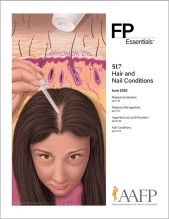
This clinical content conforms to AAFP criteria for CME.
Hypertrichosis and hirsutism can be signs of underlying conditions, some of which may be life-threatening. They also can result in significant psychosocial distress for patients. Hypertrichosis refers to excessive hair growth beyond normal variation for a patient’s age, sex, or race or for a particular body area. Hirsutism refers to an abnormal excess of hair growth solely in androgen-dependent areas of the body in females. The standard for hirsutism assessment is the modified Ferriman-Gallwey (mFG) score. Hirsutism can be idiopathic or associated with endocrine conditions, most commonly polycystic ovary syndrome (PCOS). Evaluation for underlying causes may be indicated depending on the clinical presentation. For premenopausal patients with an abnormal hirsutism score (ie, mFG score of 8 or greater), a serum total testosterone level should be obtained. If the level is normal in patients with moderate to severe hirsutism and/or evidence of a hyperandrogenic endocrine condition, an early morning serum total testosterone level and a free testosterone level should be obtained. An elevated total testosterone level indicates a hyperandrogenic state, and further testing is needed to determine if this is due to PCOS or another endocrine condition. Hair removal options for patients with hirsutism include temporary methods, electrolysis, and laser treatments. Pharmacotherapies include topical creams, combination oral contraceptives, and antiandrogens. Referral to an endocrinologist may be indicated if an underlying endocrine condition is suspected.
Already a subscriber?
Log In
Subscribe
From $350- Immediate, unlimited access to FP Essentials content
- 60 CME credits/year
- AAFP app access
- Print delivery available
Edition Access
$44- Immediate, unlimited access to this edition's content
- 5 CME credits
- AAFP app access
- Print delivery available
Interested in AAFP membership? Learn more
Learn More
